The use of foundational ontologies in biomedical research
IF 2
3区 工程技术
Q3 MATHEMATICAL & COMPUTATIONAL BIOLOGY
引用次数: 0
Abstract
The FAIR principles recommend the use of controlled vocabularies, such as ontologies, to define data and metadata concepts. Ontologies are currently modelled following different approaches, sometimes describing conflicting definitions of the same concepts, which can affect interoperability. To cope with that, prior literature suggests organising ontologies in levels, where domain specific (low-level) ontologies are grounded in domain independent high-level ontologies (i.e., foundational ontologies). In this level-based organisation, foundational ontologies work as translators of intended meaning, thus improving interoperability. Despite their considerable acceptance in biomedical research, there are very few studies testing foundational ontologies. This paper describes a systematic literature mapping that was conducted to understand how foundational ontologies are used in biomedical research and to find empirical evidence supporting their claimed (dis)advantages. From a set of 79 selected papers, we identified that foundational ontologies are used for several purposes: ontology construction, repair, mapping, and ontology-based data analysis. Foundational ontologies are claimed to improve interoperability, enhance reasoning, speed up ontology development and facilitate maintainability. The complexity of using foundational ontologies is the most commonly cited downside. Despite being used for several purposes, there were hardly any experiments (1 paper) testing the claims for or against the use of foundational ontologies. In the subset of 49 papers that describe the development of an ontology, it was observed a low adherence to ontology construction (16 papers) and ontology evaluation formal methods (4 papers). Our findings have two main implications. First, the lack of empirical evidence about the use of foundational ontologies indicates a need for evaluating the use of such artefacts in biomedical research. Second, the low adherence to formal methods illustrates how the field could benefit from a more systematic approach when dealing with the development and evaluation of ontologies. The understanding of how foundational ontologies are used in the biomedical field can drive future research towards the improvement of ontologies and, consequently, data FAIRness. The adoption of formal methods can impact the quality and sustainability of ontologies, and reusing these methods from other fields is encouraged.在生物医学研究中使用基础本体论
FAIR 原则建议使用本体等受控词汇表来定义数据和元数据概念。本体目前采用不同的建模方法,有时对相同概念的定义会相互冲突,从而影响互操作性。为了解决这个问题,以前的文献建议按层次组织本体,其中特定领域(低层次)本体以独立于领域的高层次本体(即基础本体)为基础。在这种基于层次的组织方式中,基础本体充当了预期意义的翻译者,从而提高了互操作性。尽管基础本体在生物医学研究中被广泛接受,但对基础本体进行测试的研究却寥寥无几。本文介绍了为了解基础性本体在生物医学研究中的应用情况并寻找支持其所声称的(不)优势的实证证据而进行的系统性文献映射。从79篇被选中的论文中,我们发现基础本体有几种用途:本体构建、修复、映射和基于本体的数据分析。基础本体被认为可以提高互操作性、增强推理能力、加快本体开发速度并促进可维护性。使用基础本体的复杂性是最常被提到的缺点。尽管基础性本体被用于多种目的,但几乎没有任何实验(1 篇论文)检验过使用基础性本体的利弊。在 49 篇描述本体开发的子集论文中,我们观察到对本体构建(16 篇)和本体评估正式方法(4 篇)的遵守程度较低。我们的发现有两个主要影响。首先,缺乏有关使用基础性本体的经验证据表明,有必要对生物医学研究中此类人工制品的使用进行评估。其次,对正式方法的遵守程度很低,这说明该领域在处理本体的开发和评估时可以从更系统的方法中获益。了解生物医学领域如何使用基础性本体,可以推动未来研究改进本体,从而提高数据的公平性。采用正规方法可以影响本体的质量和可持续性,鼓励从其他领域重新使用这些方法。
本文章由计算机程序翻译,如有差异,请以英文原文为准。
求助全文
约1分钟内获得全文
求助全文
来源期刊

Journal of Biomedical Semantics
MATHEMATICAL & COMPUTATIONAL BIOLOGY-
CiteScore
4.20
自引率
5.30%
发文量
28
审稿时长
30 weeks
期刊介绍:
Journal of Biomedical Semantics addresses issues of semantic enrichment and semantic processing in the biomedical domain. The scope of the journal covers two main areas:
Infrastructure for biomedical semantics: focusing on semantic resources and repositories, meta-data management and resource description, knowledge representation and semantic frameworks, the Biomedical Semantic Web, and semantic interoperability.
Semantic mining, annotation, and analysis: focusing on approaches and applications of semantic resources; and tools for investigation, reasoning, prediction, and discoveries in biomedicine.
 求助内容:
求助内容: 应助结果提醒方式:
应助结果提醒方式:


